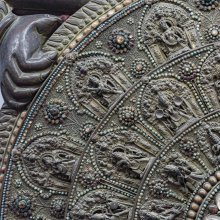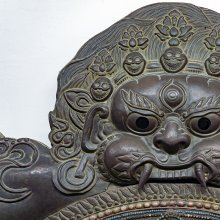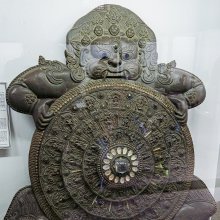Svagata, Svāgata, Svāgatā, Su-agata: 21 definitions
Introduction:
Svagata means something in Buddhism, Pali, Hinduism, Sanskrit, Marathi, Hindi. If you want to know the exact meaning, history, etymology or English translation of this term then check out the descriptions on this page. Add your comment or reference to a book if you want to contribute to this summary article.
Alternative spellings of this word include Swagat.
Images (photo gallery)
In Hinduism
Purana and Itihasa (epic history)
Source: archive.org: Shiva Purana - English TranslationSvāgata (स्वागत) refers to “welcome”, according to the Śivapurāṇa 2.3.16 (“Brahmā consoles the gods”).—Accordingly, as Brahmā said to the Gods: “O gods, welcome to you [i.e., svāgata]. I hope you are all fulfilling your duties without obstacles. Why have you all come here? Tell me”.
Source: Cologne Digital Sanskrit Dictionaries: The Purana IndexSvāgata (स्वागत).—A son of Śakuni and father of Suvarcas.*
- * Brahmāṇḍa-purāṇa III. 64. 21; Vāyu-purāṇa 89. 20.

The Purana (पुराण, purāṇas) refers to Sanskrit literature preserving ancient India’s vast cultural history, including historical legends, religious ceremonies, various arts and sciences. The eighteen mahapuranas total over 400,000 shlokas (metrical couplets) and date to at least several centuries BCE.
Natyashastra (theatrics and dramaturgy)
Source: Wisdom Library: Nāṭya-śāstraSvagata (स्वगत) refers to a type of syllabic metre (vṛtta), according to the Nāṭyaśāstra chapter 16. In this metre, the first, the third, the seventh and the tenth and the eleventh syllables of a foot (pāda) are heavy (guru), while the rest of the syllables are light (laghu).
⎼⏑⎼¦⏑⏑⏑¦⎼⏑⏑¦⎼⎼¦¦⎼⏑⎼¦⏑⏑⏑¦⎼⏑⏑¦⎼⎼¦¦
⎼⏑⎼¦⏑⏑⏑¦⎼⏑⏑¦⎼⎼¦¦⎼⏑⎼¦⏑⏑⏑¦⎼⏑⏑¦⎼⎼¦¦
Svagata falls in the Triṣṭup (Triṣṭubh) class of chandas (rhythm-type), which implies that verses constructed with this metre have four pādas (‘foot’ or ‘quarter-verse’) containing eleven syllables each.
Source: Shodhganga: Mankhaka a sanskrit literary genius (natya)Svāgatā (स्वागता) is the name of a Sanskrit metre (chandas) of the Vṛtta-type (akṣarachandas: metres regulated by akṣaras, syllabes).—The metre, Svāgatā contains eleven syllables in each and every quarter and the gaṇas are ra, na, bha. This metre is found to be employed in the Śrīkaṇṭhacarita.

Natyashastra (नाट्यशास्त्र, nāṭyaśāstra) refers to both the ancient Indian tradition (shastra) of performing arts, (natya—theatrics, drama, dance, music), as well as the name of a Sanskrit work dealing with these subjects. It also teaches the rules for composing Dramatic plays (nataka), construction and performance of Theater, and Poetic works (kavya).
Chandas (prosody, study of Sanskrit metres)
Source: Shodhganga: a concise history of Sanskrit Chanda literature1) Svāgatā (स्वागता) refers to one of the 27 metres mentioned in the Suvṛttatilaka ascribed to Kṣemendra (11th century). The Suvṛttatilaka is a monumental work of Sanskrit prosody considered as unique in its nature. In this work Kṣemendra neither introduces any new metre nor discusses all the metres used in his time. He discusses 27 popular metres (e.g., Svāgatā) which were used frequently by the poets.
2) Svāgatā (स्वागता) refers to one of the 135 metres (chandas) mentioned by Nañjuṇḍa (1794-1868 C.E.) in his Vṛttaratnāvalī. Nañjuṇḍa was a poet of both Kannada and Sanskrit literature flourished in the court of the famous Kṛṣṇarāja Woḍeyar of Mysore. He introduces the names of these metres (e.g., Svāgatā) in 20 verses.
3) Svāgatā (स्वागता) refers to one of the 130 varṇavṛttas (syllabo-quantitative verse) dealt with in the second chapter of the Vṛttamuktāvalī, ascribed to Durgādatta (19th century), author of eight Sanskrit work and patronised by Hindupati: an ancient king of the Bundela tribe (presently Bundelkhand of Uttar Pradesh). A Varṇavṛtta (e.g., svāgatā) refers to a type of classical Sanskrit metre depending on syllable count where the light-heavy patterns are fixed.
4) Svāgatā (स्वागता) refers to one of the 34 varṇavṛttas (syllabo-quantitative verse) dealt with in the Vṛttamaṇimañjūṣā, whose authorship could be traced (also see the “New Catalogus Catalogorum” XXXI. p. 7).
5) Svāgatā (स्वागता) refers to one of the seventy-two sama-varṇavṛtta (regular syllabo-quantitative verse) mentioned in the 334th chapter of the Agnipurāṇa. The Agnipurāṇa deals with various subjects viz. literature, poetics, grammar, architecture in its 383 chapters and deals with the entire science of prosody (e.g., the svāgatā metre) in 8 chapters (328-335) in 101 verses in total.

Chandas (छन्दस्) refers to Sanskrit prosody and represents one of the six Vedangas (auxiliary disciplines belonging to the study of the Vedas). The science of prosody (chandas-shastra) focusses on the study of the poetic meters such as the commonly known twenty-six metres mentioned by Pingalas.
Vaishnavism (Vaishava dharma)
Source: Pure Bhakti: Arcana-dipika - 3rd EditionSvāgata (स्वागत) refers to a “welcome” and represents one of the various articles offered during worship, according to the Arcana-dīpikā (manual on deity worship), while explaining procedures performed in the morning.—According to time and place, sixteen [viz., svāgata], twelve, ten or five articles can be employed in the worship of Śrī Bhagavān.

Vaishnava (वैष्णव, vaiṣṇava) or vaishnavism (vaiṣṇavism) represents a tradition of Hinduism worshipping Vishnu as the supreme Lord. Similar to the Shaktism and Shaivism traditions, Vaishnavism also developed as an individual movement, famous for its exposition of the dashavatara (‘ten avatars of Vishnu’).
In Buddhism
Tibetan Buddhism (Vajrayana or tantric Buddhism)
Source: Wisdom Library: Tibetan BuddhismSvāgata (स्वागत) is the name of a Śrāvaka mentioned as attending the teachings in the 6th century Mañjuśrīmūlakalpa: one of the largest Kriyā Tantras devoted to Mañjuśrī (the Bodhisattva of wisdom) representing an encyclopedia of knowledge primarily concerned with ritualistic elements in Buddhism. The teachings in this text originate from Mañjuśrī and were taught to and by Buddha Śākyamuni in the presence of a large audience (including Svāgata).

Tibetan Buddhism includes schools such as Nyingma, Kadampa, Kagyu and Gelug. Their primary canon of literature is divided in two broad categories: The Kangyur, which consists of Buddha’s words, and the Tengyur, which includes commentaries from various sources. Esotericism and tantra techniques (vajrayāna) are collected indepently.
Languages of India and abroad
Pali-English dictionary
Source: BuddhaSasana: Concise Pali-English Dictionarysvāgata : (adj.) welcome; learnt by heart.
Source: Sutta: The Pali Text Society's Pali-English DictionarySvāgata, (su+āgata) 1. welcome Vin. II, 11; Th. 2, 337; ThA. 236.—2. learnt by heart Vin. II, 95, 249; A. IV, 140 (pātimokkhāni). See sāgata. (Page 727)

Pali is the language of the Tipiṭaka, which is the sacred canon of Theravāda Buddhism and contains much of the Buddha’s speech. Closeley related to Sanskrit, both languages are used interchangeably between religions.
Marathi-English dictionary
Source: DDSA: The Molesworth Marathi and English Dictionarysvāgata (स्वागत).—n (S su & āgata Well and come.) Welcoming, welcome, courteous reception of a visitor.
Source: DDSA: The Aryabhusan school dictionary, Marathi-Englishsvāgata (स्वागत).—n Welcome, courteous reception of a visitor.
Marathi is an Indo-European language having over 70 million native speakers people in (predominantly) Maharashtra India. Marathi, like many other Indo-Aryan languages, evolved from early forms of Prakrit, which itself is a subset of Sanskrit, one of the most ancient languages of the world.
Sanskrit dictionary
Source: DDSA: The practical Sanskrit-English dictionarySvāgata (स्वागत).—[sukhena āgataṃ suṣṭhu āgataṃ vā] Welcome, happy arrival (used chiefly in greeting a person who is put in the dative case); स्वागतं देव्यै (svāgataṃ devyai) M.1; (tasmai) प्रीतः प्रीति- प्रमुखवचनं स्वागतं व्याजहार (prītaḥ prīti- pramukhavacanaṃ svāgataṃ vyājahāra) Meghadūta 4; स्वागतं स्वानधीकारान् प्रभावै- रवलम्ब्य वः । युगपद् युगबाहुभ्यः प्राप्तेभ्यः प्राज्यविक्रमाः (svāgataṃ svānadhīkārān prabhāvai- ravalambya vaḥ | yugapad yugabāhubhyaḥ prāptebhyaḥ prājyavikramāḥ) Kumārasambhava 2. 18. -a.
1) Welcome.
2) Lawfully earned (as money); श्रद्धाकृते ह्यक्षये ते भवतः स्वागतैर्घनैः (śraddhākṛte hyakṣaye te bhavataḥ svāgatairghanaiḥ) Manusmṛti 4.226.
Derivable forms: svāgatam (स्वागतम्).
--- OR ---
Svāgata (स्वागत).—see s. v.
Svāgata is a Sanskrit compound consisting of the terms su and āgata (आगत).
Source: Cologne Digital Sanskrit Dictionaries: Edgerton Buddhist Hybrid Sanskrit DictionarySvāgata (स्वागत).—(= Pali Sāgata), name of a disciple of the Bud-dha: Mahāvyutpatti 1067; Saddharmapuṇḍarīka 207.4; Lalitavistara 2.3; Sukhāvatīvyūha 2.10; Mūla-Sarvāstivāda-Vinaya i.185.1 ff.; long account of him Divyāvadāna 169.22 ff., including several traits of the story of Pali Sāgata, e.g. his contest of magic with a nāga (Aśvatīrthika) 185.5 ff.; the Buddha's calling him foremost among experts in use of the fire- element (tejodhātu), 186.12, 19 ff.; and his falling a victim to intoxication, 190.4 ff.
Source: Cologne Digital Sanskrit Dictionaries: Shabda-Sagara Sanskrit-English DictionarySvagata (स्वगत).—mfn.
(-taḥ-tā-taṃ) Kept to one’s self, apart, asiden.
(-taṃ) Aside, (in theatrical language.) E. sva self, gata gone, got.
--- OR ---
Svāgata (स्वागत).—n.
(-taṃ) 1. Welcome, salutation. 2. Happy arrival; (in greeting this word is generally used with the dative of the person greeted.) f.
(-tā) A species of the Trishtubh metre. E. su well, and āgata come.
Source: Cologne Digital Sanskrit Dictionaries: Cappeller Sanskrit-English DictionarySvagata (स्वगत).—[adjective] relating or belonging to one’s self; [neuter] [adverb] apart, aside.
--- OR ---
Svāgata (स्वागत).—[adjective] welcome (also lit. well come i.e. well acquired); [neuter] welcome, salutation, tī kṛ make into a welcome.
Source: Cologne Digital Sanskrit Dictionaries: Monier-Williams Sanskrit-English Dictionary1) Svagata (स्वगत):—[=sva-gata] [from sva] a mfn. belonging to o°’s self, own, [Harivaṃśa; Kāvya literature; Vedāntasāra; Bhāgavata-purāṇa]
2) [v.s. ...] passing in o°’s own mind, spoken to o°’s self, apart, [Horace H. Wilson]
3) Svāgata (स्वागत):—[from sva] a mfn. (for sv-āg See p.1283) come of o°’s self, [Monier-Williams’ Sanskrit-English Dictionary]
4) Svagata (स्वगत):—[=sva-gata] b sva-guṇa etc. See p. 1275, col. 2.
5) Svāgata (स्वागत):—[=sv-āgata] b mfn. (for svāgata See p. 1277, col. 2) well come, welcome, [Rāmāyaṇa]
6) [v.s. ...] lawfully-earned (as money), [Manu-smṛti iv, 226]
7) [v.s. ...] m. Name of a Buddha, [Lalita-vistara]
8) [v.s. ...] of a king, [Viṣṇu-purāṇa]
9) [v.s. ...] of another man, [Buddhist literature]
10) Svāgatā (स्वागता):—[=sv-āgatā] [from sv-āgata] f. a kind of metre, [Śrutabodha]
11) Svāgata (स्वागत):—[=sv-āgata] n. welcome, greeting, salutation (svāgataṃ te with or without astu, ‘I wish you welcome’), [Mahābhārata; Kāvya literature etc.]
12) [v.s. ...] welfare, health (See next).
Source: Cologne Digital Sanskrit Dictionaries: Yates Sanskrit-English Dictionary1) Svagata (स्वगत):—[sva-gata] (taḥ-tā-taṃ) a. Kept to one’s self; apart, aside.
2) Svāgata (स्वागत):—[svā+gata] (taṃ) 1. n. Welcome, salutation. f. A kind of metre.
Source: DDSA: Paia-sadda-mahannavo; a comprehensive Prakrit Hindi dictionary (S)Svāgata (स्वागत) in the Sanskrit language is related to the Prakrit word: Sāgaya.
[Sanskrit to German]
Sanskrit, also spelled संस्कृतम् (saṃskṛtam), is an ancient language of India commonly seen as the grandmother of the Indo-European language family (even English!). Closely allied with Prakrit and Pali, Sanskrit is more exhaustive in both grammar and terms and has the most extensive collection of literature in the world, greatly surpassing its sister-languages Greek and Latin.
Hindi dictionary
Source: DDSA: A practical Hindi-English dictionary1) Svagata (स्वगत) [Also spelled swagat]:—(a) aside, speaking to oneself; ~[kathana/bhāṣaṇa] aside, soliloquy; •[karanā] to soliloquize.
2) Svāgata (स्वागत) [Also spelled swagat]:—(nm) welcome, reception; -[abhibhāṣaṇa] welcome address; -[kakṣa] reception room; -[samiti] reception committee; -[samāroha] a reception; [svāgatī] a receptionist; —[karanā] to welcome, to receive.
...
Kannada-English dictionary
Source: Alar: Kannada-English corpusSvagata (ಸ್ವಗತ):—
1) [adjective] of or belonging to oneself; own.
2) [adjective] turned one’s inward (as one’s speech, thought, etc.) 3) included; consisting of.
--- OR ---
Svagata (ಸ್ವಗತ):—
1) [noun] that which one has (withing oneself.
2) [noun] one who concentrates his views on one’s self, one’s spiritual identify, etc.; an introverted seeker of truth or knowledge.
3) [noun] an act or instance of talking to oneself.
4) [noun] (drama.) such a speech in a drama which is supposed not to be heard by other characters on the stage; soliloquy.
--- OR ---
Svāgata (ಸ್ವಾಗತ):—
1) [noun] a welcoming.
2) [noun] an act or expression of welcoming.
3) [noun] (pros.) a metrical verse of four lines, each having three groups of three syllables each, followed by two long syllables (-u-, uuu, -uu, -, -).
Kannada is a Dravidian language (as opposed to the Indo-European language family) mainly spoken in the southwestern region of India.
See also (Relevant definitions)
Partial matches: Sv, Gata, Agata, Shva, Cu, Shu.
Starts with: Svagata-abhivadana, Svagata-gana, Svagata-kathana, Svagata-samaroha, Svagatabhashana, Svagatakarta, Svagatam, Svagataprashna, Svagatavacana, Svagatavant.
Ends with: Agata-svagata, Agatasvagata, Apehisvagata, Asvagata, Parshvagata, Pashrnipashrvagata, Racitasvagata, Susvagata, Vishvagata.
Full-text (+31): Svagatam, Svagatabhashana, Svagataprashna, Svagama, Svagatika, Apehikata, Svagatavacana, Shodashopacara, Svagatikri, Apehisvagata, Cuvakatam, Agata, Svagata-kathana, Atmagata, Ehisvagatavadin, Cukatapetam, Cuvakatapetam, Swaagat-gaan, Sukhagata, Svagatikar.
Relevant text
Search found 36 books and stories containing Svagata, Svāgata, Svāgatā, Su-agata, Su-āgata, Sva-gata, Sv-agata, Sv-āgata, Sv-āgatā; (plurals include: Svagatas, Svāgatas, Svāgatās, agatas, āgatas, gatas, āgatās). You can also click to the full overview containing English textual excerpts. Below are direct links for the most relevant articles:
Hanuman Nataka (critical study) (by Nurima Yeasmin)
12.4. Nāṭyokti (dramatic technique) in the Hanumannāṭaka < [Chapter 4]
Hanuman-Nāṭaka, Act 9 (Summary) < [Chapter 3]
Brihad Bhagavatamrita (commentary) (by Śrī Śrīmad Bhaktivedānta Nārāyana Gosvāmī Mahārāja)
Verse 2.4.81 < [Chapter 4 - Vaikuṇṭha (the spiritual world)]
Garga Samhita (English) (by Danavir Goswami)
Verse 2.17.24 < [Chapter 17 - The Meeting of Śrī Rādhā-Kṛṣṇa]
Dasarupaka (critical study) (by Anuru Ranjan Mishra)
Part 11 - Technical Aspects of a Ḍima < [Chapter 4 - Ḍima (critical study)]
Part 13 - Technical Aspects of a Nāṭaka < [Chapter 1 - Nāṭaka (critical study)]
Part 11 - The technical aspects of a Prahasana < [Chapter 3 - Prahasana (critical study)]
Atithi or Guest Reception (study) (by Sarika. P.)
Part 9 - References to Hospitality in Mālavikāgnimitra < [Chapter 4 - Atithi-saparyā in Classical Sanskrit Literature]
Part 7 - References to Hospitality in Abhijñānaśākuntala < [Chapter 4 - Atithi-saparyā in Classical Sanskrit Literature]
Part 5 - How to appease an Atithi? < [Chapter 9 - Atithi-saparyā in Dharmaśāstra Literature]
Chandogya Upanishad (Madhva commentary) (by Srisa Chandra Vasu)



